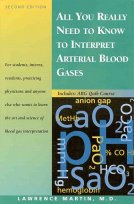TRUE-FALSE QUIZ -- THE FOUR MOST IMPORTANT EQUATIONS IN CLINICAL PRACTICE
Lawrence Martin, M.D., FACP, FCCP
Clinical Associate Professor of Medicine
Case Western Reserve University School of Medicine
Cleveland, Ohio

Directions: This quiz is designed to test your understanding
of information in the review paper,
The Four Most Important Equations in Clinical Practice..
For each of the following five numbered statements or questions,
there are five lettered responses (a-e), each of which
may be true or false. Circle the correct or true responses.
Answers immediately follow the quiz.
1. Normal range for PaCO2 is 35-45 mm Hg. A change in PaCO2 from
normal to 28 mm Hg means the subject
a) is hyperventilating.
b) has excess alveolar ventilation for the amount of CO2 production.
c) must have hypoxia, anxiety, and/or metabolic acidosis.
d) must be breathing faster than normal.
e) must have acute respiratory alkalosis.
2. The arterial PO2 is predicted to be reduced to some extent from
a) anemia.
b) ventilation-perfusion (V-Q) imbalance with an increase in the number of low V-
Q units.
c) increased PCO2, while the subject is breathing room air.
d) carbon monoxide poisoning.
e) altitude.
3. To obtain a reasonable idea of the acid-base state of a patient's blood,
you would need to know the
a) pH and PaCO2.
b) pH and PaO2.
c) PaCO2 and PaO2.
d) PaCO2 and HCO3-.
e) pH and SaO2 (%saturation of hemoglobin with oxygen).
4. Arterial blood gas data (pH, PaCO2, PaO2, SaO2) are related in some simple
but important ways. Which of the following are valid relationships?
a) Alveolar PO2 is related to PaCO2 by the alveolar gas equation: as PaCO2 goes
up, alveolar PO2 goes down.
b) PaO2 is inversely related to blood pH: as pH goes up, PaO2 goes down.
c) If PaCO2 increases while HCO3- remains unchanged, pH always goes down.
d) PaO2 is related to SaO2 on a linear scale (i.e., a straight-line relationship).
e) The SaO2 is related to hemoglobin-bound arterial oxygen content on a linear
scale (i.e., a straight-line relationship).
5. There are some "truisms" in terminology and physiology for proper blood gas
interpretation. They include which of the following?
a) "Hyperventilation" and "hypoventilation" are clinical terms, and are not
diagnosed by arterial blood gases.
b) The alveolar-arterial PO2 difference increases with age and with increase in the
fraction of inspired oxygen.
c) The arterial PO2 cannot go above 100 mm Hg while breathing room air at sea
level.
d) A continuously negative alveolar-arterial PO2 difference is incompatible with
life.
e) If arterial pH is normal, the patient cannot have a clinically significant acid-base
disorder.
A N S W E R S
1. a and b are true.
The patient may have hyperventilation from many causes (including
voluntary hyperventilation). The subject may be breathing deeper than normal, rather than
faster. And the subject may be hyperventilating to compensate for metabolic acidosis, which
would not be a respiratory alkalosis.
2. b, c and e are true; other responses are false.
Anemia and carbon monoxide poisoning do not affect PaO2
(except when there is a ventilation-perfusion imbalance and some right to
left shunting).
3. a and d are true. You need to know two of the three Henderson-Hasselbalch equation
variables to assess acid-base status.
4. a, c and e are true. PaO2 and pH are not related in any formal way. The relationship of
PaO2 to SaO2 is sigmoid-shaped, not straight line.
5. b and d are true. Hyperventilation and hypoventilation are specifically not defined by
clinical or bedside criteria, but by changes in PaCO2. The PaO2 can easily go above 100
mm Hg with hyperventilation and normal lungs. Arterial pH can be normal with two or
more acid-base disorders occurring at the same time.
Forward any comments to:
larry.martin@roadrunner.com
Copyright © 1996-2009 Lawrence Martin, M.D.
| |